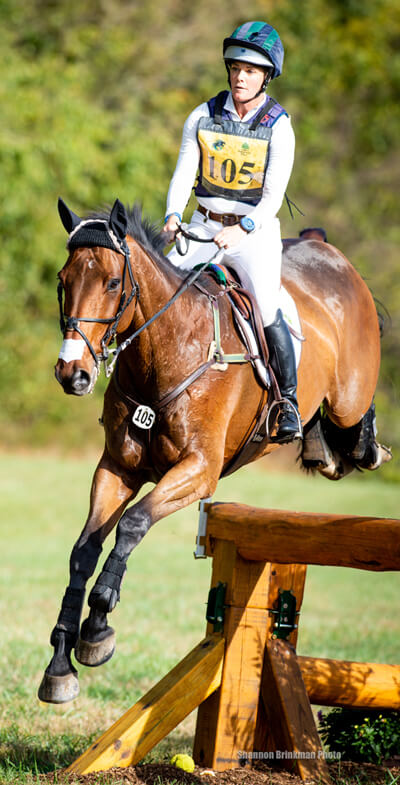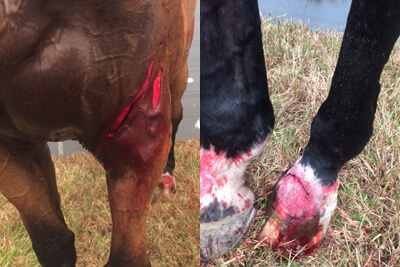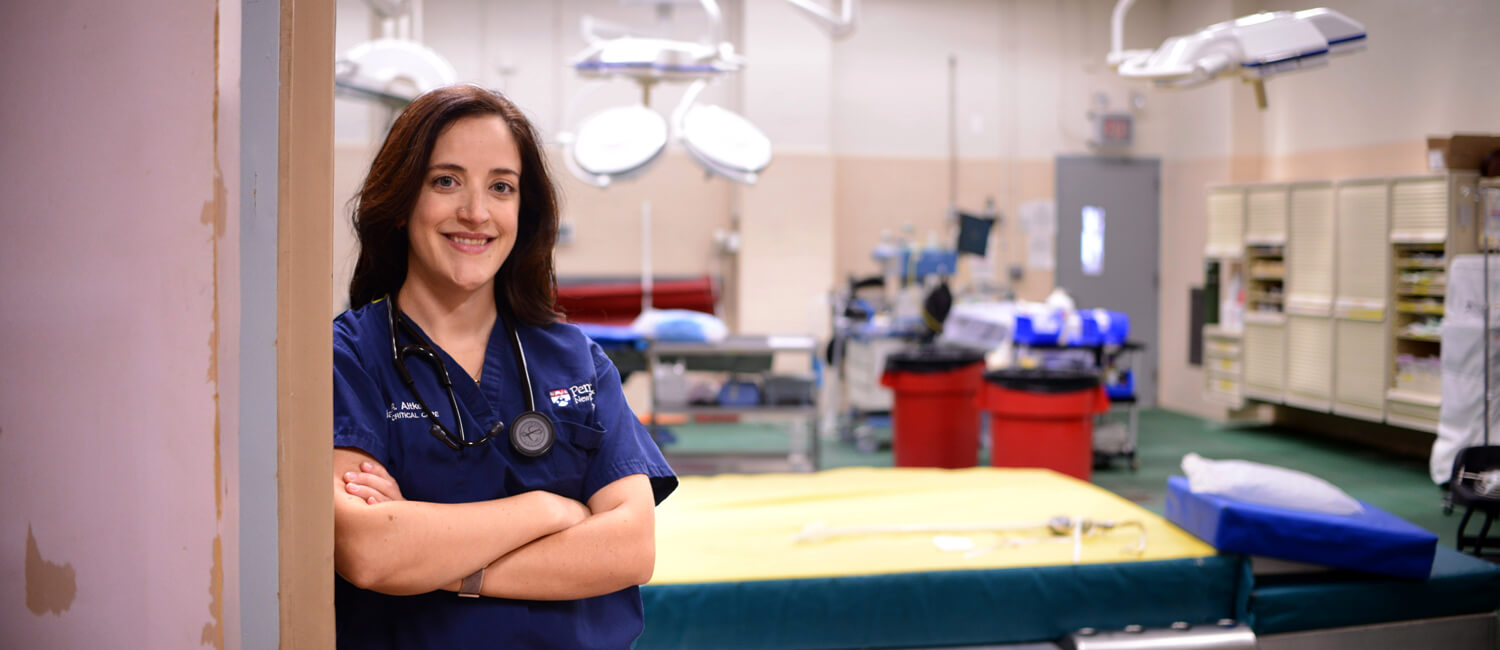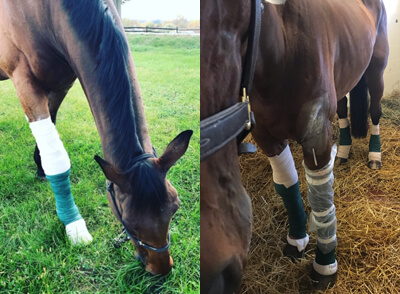 Rider Liza Horan and her horse Flip Flop had a mysterious accident at Fair Hill International. Liza walked away unharmed. Flip Flop suffered injuries while fleeing the course. Photo by Shannon Brinkman.
Rider Liza Horan and her horse Flip Flop had a mysterious accident at Fair Hill International. Liza walked away unharmed. Flip Flop suffered injuries while fleeing the course. Photo by Shannon Brinkman.
Lafite, aka Flip Flop, and his rider/owner Liza Horan were having a great round at Fair Hill International when an accident mid-course led to a strange chain of events and potentially career- or even life-threatening injuries for the 12-year-old warmblood gelding.
“Something very bizarre happened,” said Horan, who trains at Ironwood Ranch in Lompoc, California, and made the trip with three horses to Maryland for the October 2019 event. “The jump was pretty straightforward, and I thought I had a good shot as far as my approach and distance. It seemed that Flip Flop would jump it quite easily. But when he started to leave the ground, he grabbed his left front shoe in a way that felt like it nailed his leg to the floor. His front leg didn’t come off the ground, and he hit the rail of the jump really hard. He went almost vertical with his hind legs and made a heroic effort not to fall down.”
Although the horse succeeded in not falling, Horan was unseated during the accident. Medics attended to her, while Flip Flop galloped away, seemingly unphased. What happened next remains a mystery.
“He didn’t appear frantic when he took off,” Horan explained. “But I realize now he was a bit spooked by my fall — I’d never fallen from him.”
After medics cleared her, Horan went looking for her horse, who’d gotten off course. When horse and rider did reconnect about 5 minutes later in the stables, “he looked like he’d been hit by a semi-truck,” Horan said. “He had multiple wounds and lacerations inconsistent with the accident. A few people saw him on the Fair Hill grounds — we know at one point he was in the parking lot and hit a parked car — but we don’t have a full picture of those minutes after the accident.”
No Time to Lose
Flip Flop needed immediate medical attention, leaving no time for Horan to retrace his steps. Veterinarian Dr. Bernadette Smith of Equine Veterinary Care at Fair Hill Training Center examined him and found wounds on all four legs. Several were in areas that, if infected, could have meant a poor prognosis for the animal.
 Although some of them looked gory, not all of Flip Flop’s injuries were life-threating. The dangerous lacerations were almost invisible on photos, while the bloodier ones (like these) required stitching but weren’t too risky.
Although some of them looked gory, not all of Flip Flop’s injuries were life-threating. The dangerous lacerations were almost invisible on photos, while the bloodier ones (like these) required stitching but weren’t too risky.
“The locations of his lacerations were a big red flag,” said Smith. “Not for the size of them but for where they were on his body — any lacerations on a horse are potentially career- or life-ending, it depends on the location and which structures are involved. Some of Flip Flop’s cuts were near joints — a terrible location — and he needed immediate specialty care.”
Smith referred him right to New Bolton Center, where his case would have the full attention of multiple specialists in one location: surgeons, criticalists, radiologists, anesthesiologists, and others who would make any necessary tests and treatments coordinated and swift.
“In cases like these, having New Bolton Center as a referring facility can mean the difference between death or life,” explained Smith. “It’s always in the best interest of the horse to be cared for in a hospital that has a full team of specialists on site, where they can do everything needed in good time and as a team.”
Location, Location, Location
At New Bolton Center, Dr. Maia Aitken met Flip Flop and Horan. She immediately assessed the full extent of his injuries and checked all his vitals; heart and respiratory rates and temperature were normal.
“He was walking well, but with trauma there can be a lot of adrenaline that can mask underlying damage,” said Aitken, who is double board-certified in surgery and emergency and critical care. “So, we took several radiographs to look for signs of fractures and found none. And then we systematically looked carefully at each joint, each wound, and the joints close to each wound.”
In a full accounting of his injuries, the horse had lacerations on his left axillary region or armpit area, left proximal antebrachium or forearm, and left front heel bulb, where he had clipped his heel during the accident. He also had a large laceration at the inside of his right stifle and gaskin as well as his left hind pastern. There were also two very small lacerations over his right knee — or carpus — that did communicate with the radiocarpal joint, which acts like a hinge in the knee.
 Dr. Maia Aitken at New Bolton Center
Dr. Maia Aitken at New Bolton Center
“These were the smallest lacerations but also held the most risk,” said Aitken. “I can’t stress enough that prognosis is all about location, location, location. Flip Flop had a large wound over his armpit, which involves a lot of suturing but wasn’t a great risk to the horse. Yet the two one-centimeter lacerations over his carpus looked like no big deal but were the most threatening because of the potential for infection.”
A Stitch in Good Time...
Flip Flop arrived at New Bolton Center within the window of time where, with specialized and aggressive emergency care, his wounds were treatable.
Aitken said, “We have really astute referring veterinarians who can quickly identify life-threatening locations because they know their anatomy very well, or they can inspect whether the laceration communicates with a joint or not.”
A board-certified anesthesiologist placed him under general anesthesia, and Aitken and her team got to work. To prevent joint contamination from becoming an established infection, the radiocarpal joint was lavaged with a large volume of sterile fluid and injected with antimicrobials. In addition, each wound was thoroughly debrided and lavaged and then meticulously closed with numerous sutures. All of his repaired lacerations were bandaged and he was moved to a padded recovery stall.
“He recovered uneventfully from the anesthesia and was an absolutely perfect patient while he was with us,” said Aitken. In the postoperative period, Flip Flop was treated aggressively with systemic and local antimicrobials as well as pain medication, wound care, and bandaging.
 Flip Flop recovered at New Bolton Center and home
Flip Flop recovered at New Bolton Center and home
without a care in the world.
While the horse rested under Aitken’s watchful eye, Horan made the best of a few unexpected days off. “Flip Flop was in the best hands at New Bolton Center — he was recovering nicely and, had there been any complications, he would have received immediate, amazing care,” she said. “While he rested, in between visits with him, I caught up with old friends, including some of the New Bolton Center doctors, whom I knew from taking horses to Penn Vet when I used to live in the area.”
After a week in the hospital, Flip Flop was ready for the long trip back to the West Coast, where his caregivers would monitor his wounds and ease him back into a regular routine.
Now home in California, Horan remains haunted by what happened in the missing minutes after Flip Flop’s accident. The horse, however, doesn’t appear too concerned. “It looks like he’s going to make a full recovery and won’t miss any part of the competition season,” she said. “It’s amazing. And it’s thanks to Penn Vet.”